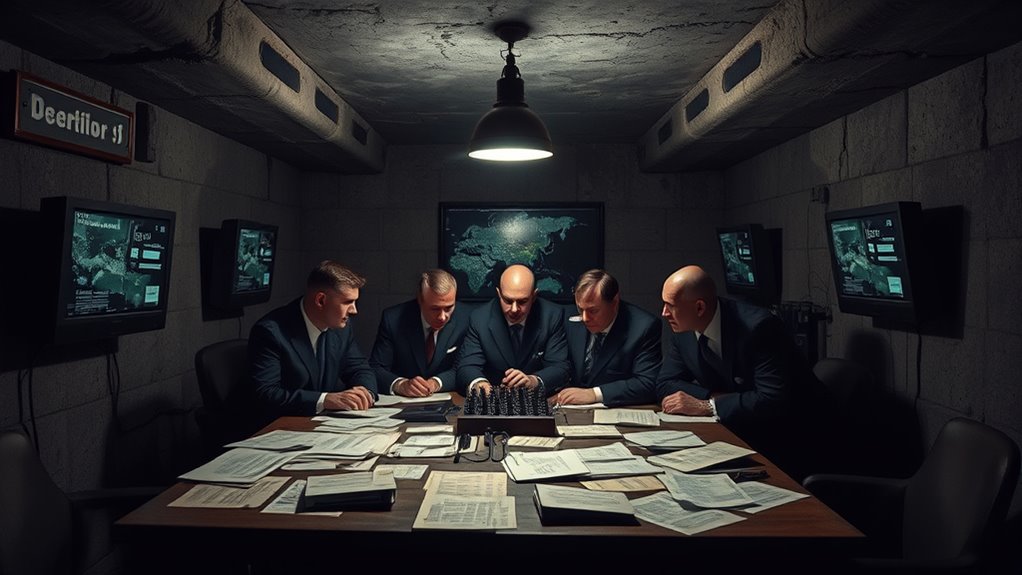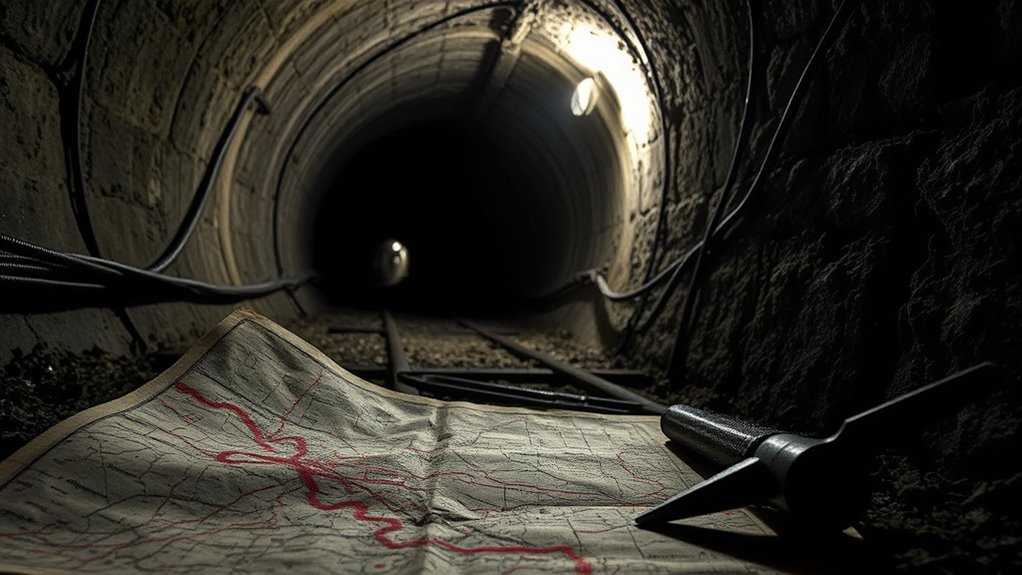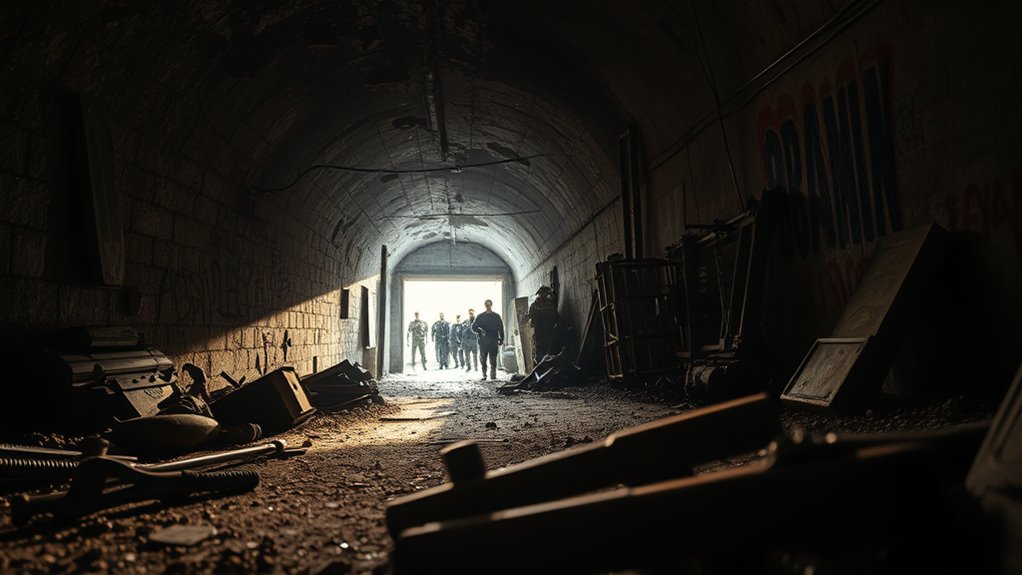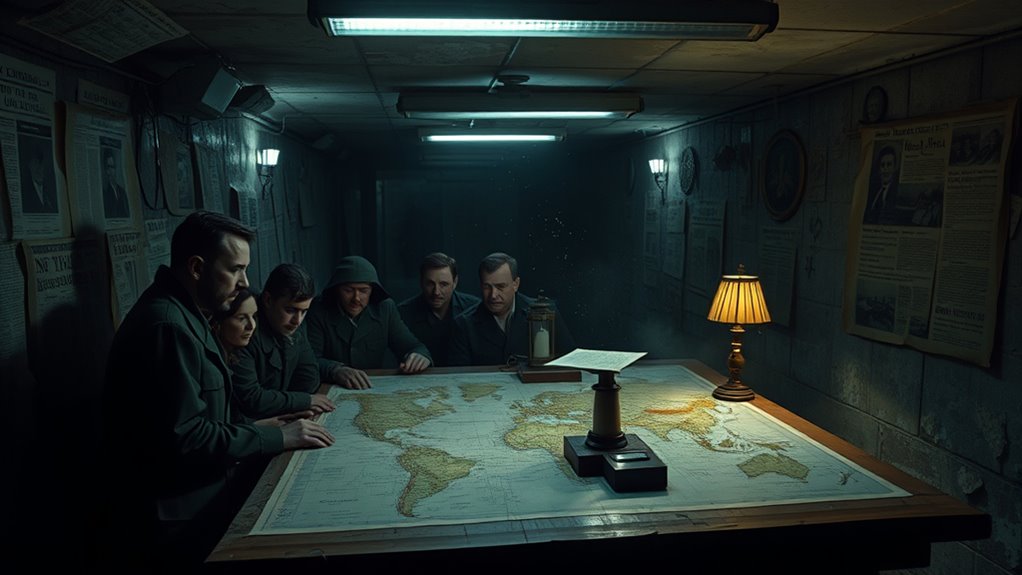Berlin’s underground punk scene was a game-changer during the Cold War, offering a bold form of resistance against the East German regime. While the CIA’s Operation Gold aimed to eavesdrop on Soviet communications, punks risked it all to express their defiance through music and fashion. This cultural movement fostered unity among youth and sparked societal change, contributing to the fall of the Berlin Wall. Discover how these acts of rebellion shaped history in unexpected ways.
Key Takeaways
- Berlin’s divided status epitomized Cold War tensions, influencing global power dynamics and intelligence operations.
- Operation Gold exemplified high-stakes espionage, revealing vulnerabilities in CIA tactics against Soviet communications.
- The discovery of the tunnel prompted a reassessment of covert intelligence methods and security protocols for the CIA.
- The underground punk scene in East Berlin symbolized cultural resistance, energizing movements that contributed to the fall of the Berlin Wall.
- Espionage and cultural rebellion in Berlin played critical roles in shaping East-West relations and the broader Cold War narrative.
The Strategic Importance of Berlin in the Cold War

When you think about the Cold War, Berlin stands out as a pivotal battleground, divided into East and West sectors that embodied the clash between communism and democracy.
The city’s strategic location made it a hotspot for intelligence operations, where both sides engaged in espionage to gain the upper hand.
The Berlin Blockade from 1948 to 1949 highlighted its significance, as the Soviet Union attempted to isolate West Berlin, leading to the Allied powers’ heroic Berlin Airlift.
The construction of the Berlin Wall in 1961 solidified this divide, marking a physical and ideological barrier between East and West.
Major political decisions made in Berlin shaped Cold War history, influencing the future of Europe and the global balance of power.
Operation Gold: The CIA’s Covert Tunnel

You might be surprised by the innovative tunneling techniques the CIA used in Operation Gold.
This covert operation not only showcased advanced engineering but also resulted in a significant haul of intelligence that shaped future strategies.
As you explore the successes and challenges of this mission, consider how it reflects the intricate dance of espionage during the Cold War.
Tunneling Techniques and Innovations
Although covert operations often rely on high-tech equipment, the ingenuity of tunneling techniques played a crucial role in the success of Operation Gold.
Constructed by the U.S. Army Corps of Engineers, the 1,476-foot tunnel tapped directly into Soviet communications, demonstrating remarkable engineering skill. The team implemented an advanced steel liner system, ensuring structural integrity and security.
Beginning in February 1954 under the guise of a radar site, this covert operation drew inspiration from earlier British intelligence efforts like Operation Silver.
With sophisticated listening devices installed, the tunnel intercepted around 50,000 hours of essential conversations over 11 months. Despite its eventual discovery, Operation Gold proved the effectiveness of innovative tunneling techniques during the Cold War, generating 1,750 intelligence reports.
Intelligence Gathering Successes
Building on the innovative tunneling techniques showcased in Operation Gold, the CIA’s covert tunnel operation marked a significant triumph in Cold War intelligence gathering. Launched in 1954, this 1,476-foot tunnel tapped into Soviet communication cables, allowing you to monitor over 500 connections and record approximately 50,000 reels of tape.
This operation yielded 443,000 conversations over 40,000 hours, creating 1,750 intelligence reports that provided vital insights into Soviet troop movements and military strategies.
However, a breach by British double agent George Blake alerted the Soviets, who continued using the lines while aware of the monitoring. Despite its eventual discovery in 1956, Operation Gold set important precedents for future covert operations and emphasized the complexities of Cold War espionage.
The Role of Espionage in East-West Relations

You can see how espionage shaped East-West relations during the Cold War, especially through operations like Gold.
Intelligence gathering strategies not only provided essential insights but also influenced military actions and political decisions.
This cat-and-mouse game revealed both the strengths and vulnerabilities of each side, setting the stage for future covert operations.
Intelligence Gathering Strategies
As the Cold War intensified, intelligence gathering strategies became essential in shaping East-West relations, with espionage playing a pivotal role.
Operation Gold, initiated by the CIA in 1954, exemplified these high-stakes efforts, aimed at eavesdropping on Soviet communications in Berlin. By tapping into underground cables, you’d monitor over 500 connections and 121 voice circuits simultaneously, capturing about 50,000 reels of critical intelligence, including Soviet military strategies.
Collaborating with British operations showcased the united front against a common enemy. However, the betrayal by George Blake, a British double agent who leaked details to the KGB, emphasized the risks of espionage. This intricate web of espionage tactics not only shaped the course of the Cold War but also influenced modern intelligence operations.
Operation Gold set precedents for future covert missions, proving just how far intelligence agencies would go to infiltrate enemy communications during the Cold War.
Impact on Cold War
While espionage often operates in the shadows, its impact on Cold War dynamics was profound and far-reaching.
Operation Gold, initiated by the CIA in 1954, aimed to infiltrate Soviet communications in East Berlin, collecting essential intelligence on military activities. You’d find it fascinating that this operation intercepted around 50,000 reels of tape and 443,000 conversations, revealing significant insights into Soviet troop movements.
However, the betrayal by George Blake compromised its effectiveness, exposing vulnerabilities within Western intelligence agencies. The subsequent discovery of the tunnel by Soviet authorities in 1956 highlighted the risks involved in covert operations.
Ultimately, Operation Gold set a precedent for intelligence gathering, emphasizing its key role in shaping East-West relations during the Cold War. This operation underscored the importance of continuous monitoring in ensuring the effectiveness of intelligence efforts.
Key Figures Behind Operation Gold

Operation Gold, a covert mission aimed at tapping into Soviet communications, relied heavily on the expertise of key figures whose decisions shaped its course.
William Harvey, a seasoned CIA veteran, led the operation, utilizing his counterintelligence background and prior Berlin experience. Under the approval of CIA Director Allan Dulles, the U.S. Army Corps of Engineers began digging a tunnel into the Soviet sector, disguised as a radar site.
This operation showcased a significant collaboration between the CIA and MI6, reflecting the urgency of intercepting Soviet communications during the Cold War.
However, George Blake, an MI6 agent and double agent for the KGB, ultimately undermined these efforts by leaking essential details to Soviet authorities, jeopardizing the mission before it even began.
The Betrayal of George Blake

Despite being a trusted MI6 agent, George Blake’s allegiance to the Soviet Union transformed him into one of the most notorious double agents in history.
As a mole, Blake leaked crucial information about Western intelligence operations, including Operation Gold, to the KGB. His betrayal came before the operation even began, alerting the Soviets to the CIA’s plans to tap into their communications in Berlin.
This allowed the Soviet military to use the tapped lines while knowing they were under surveillance, severely undermining CIA efforts.
Arrested in 1961 for espionage and sentenced to 42 years, Blake’s escape to the Soviet Union solidified his legacy as a significant intelligence failure, exposing vulnerabilities in Cold War espionage practices.
Consequences of the Tunnel’s Discovery

The discovery of the tunnel on April 21, 1956, marked a turning point for the CIA, as it exposed significant flaws in their intelligence operations.
Heavy rainfall had flooded the area, revealing the wires and alerting Soviet forces to Operation Gold‘s intentions.
With British double agent George Blake already compromising the operation, the CIA faced a considerable loss of intelligence capabilities in East Berlin.
This operational failure forced you to reassess your covert methods and security protocols.
The tunnel’s discovery underscored the vulnerabilities in espionage tactics during the Cold War, highlighting the urgent need for more secure and covert intelligence operations.
Ultimately, it became a lesson in the risks associated with relying on outdated methods in a rapidly changing geopolitical landscape.
The Impact of Operation Gold on Intelligence Operations

While many viewed Operation Gold as a failure due to its premature exposure, it actually had a profound impact on intelligence operations during the Cold War.
This covert endeavor allowed the CIA to monitor over 500 connections and 121 voice circuits, yielding 1,750 intelligence reports filled with valuable insights into Soviet military strategies and troop movements.
Even after the leak by Soviet mole George Blake, the operation demonstrated the effectiveness of tunneling methods, influencing future CIA missions.
The fallout emphasized the need for enhanced security in intelligence operations, leading to stricter planning and execution protocols.
Operation Gold set a critical precedent, showcasing both the rewards and vulnerabilities of espionage during a tense and transformative period in history.
Cultural Resistance: The Underground Punk Scene in Berlin

Emerging from the shadows of oppression, Berlin’s underground punk scene became a powerful form of cultural resistance against the East German regime. This vibrant movement thrived despite the East German Communist government’s severe repression of punk music.
You’d see punks risking arrest, expressing their defiance through bold fashion and raw sound. Influenced by Western ideals, they covertly shared music via radio and gathered in secret locations like cellars and churches.
- Underground performances became symbols of rebellion.
- Events like the Blues Mass offered safe havens for expression.
- Punk music fostered a sense of community among youth.
- This cultural resistance ultimately energized movements that led to the Berlin Wall’s collapse.
Frequently Asked Questions
What Was the Significance of Berlin During the Cold War?
Berlin was essential during the Cold War, serving as the frontline of ideological conflict between the East and West.
You’d see how its division symbolized the struggle between communism and democracy. The city hosted significant events like the Berlin Blockade and the construction of the Berlin Wall, which solidified this divide.
You’d also witness the vibrant underground culture in West Berlin, reflecting resistance and artistic expression against the oppressive regime in the East.
Why Did the KGB Not Reveal the Existence of the Tunnel to the Russian Military?
The KGB didn’t reveal the tunnel’s existence to the Russian military to maintain secrecy and leverage. By keeping it hidden, they could continue to gather intelligence from Western communications without alerting the CIA.
This strategic omission allowed them to exploit vulnerabilities in Western espionage efforts, ensuring they could monitor NATO activities and Soviet military movements without interference.
The KGB’s decision illustrates the complexities of intelligence operations during the Cold War, prioritizing advantage over collaboration.
What Is the CIA Tunnel Under the Berlin Wall?
The CIA tunnel under the Berlin Wall was a secret operation designed to monitor Soviet communications. It connected West Berlin to Soviet lines, allowing you to tap into vital intelligence.
Built in 1954, it stretched 1,476 feet, housing advanced listening devices. Despite a double agent leaking information, the tunnel recorded thousands of conversations, providing valuable insights.
Ultimately, it showcased the lengths you’d go to during the Cold War for national security.
How Did the Soviets Learn About the Tunnel?
The Soviets learned about the tunnel primarily through George Blake, a double agent who leaked information to them before construction even started.
They were already aware of Operation Gold and kept a close watch on the tapped lines.
When heavy rainfall flooded the tunnel in April 1956, it exposed critical wires, leading to its discovery by a Soviet maintenance crew.
This combination of inside knowledge and fortunate circumstances led to the tunnel’s exposure.
Conclusion
As you ponder the tangled web of espionage and intrigue that defined Berlin during the Cold War, the shadow of Operation Gold looms large. What if the secrets unearthed beneath the city had never been discovered? The stakes were high, and the fallout was immense, reshaping intelligence operations for years to come. As you explore deeper into this clandestine world, you can’t help but wonder: how many more secrets lie hidden, waiting to be uncovered?









